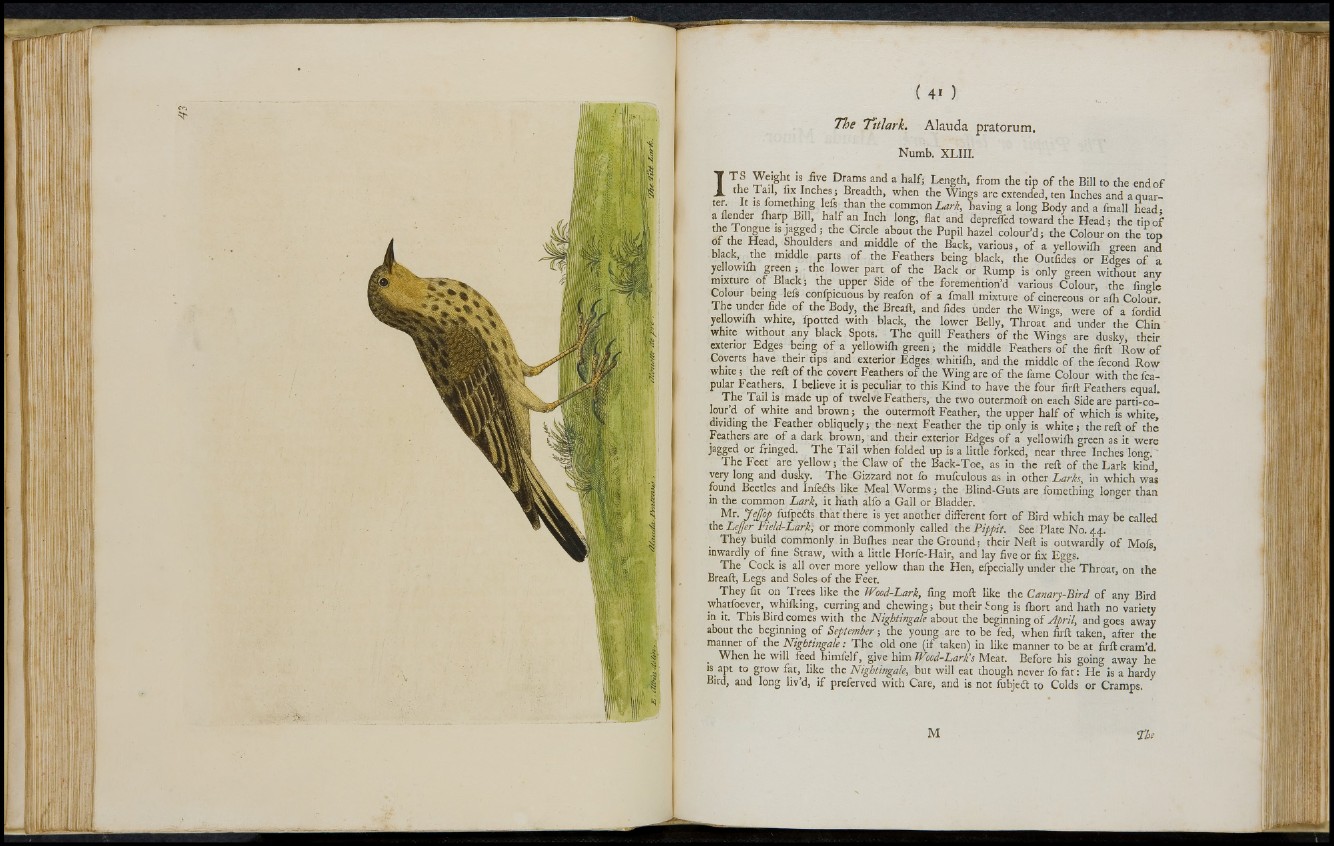
The Titlark. Alauda pratorum.
Numb. XLIII.
ITS Weight is .five Drams and a half; Length, from the tip of the Bill to the end of
t r ai ’ , Inches ; Breadth, when the Wings are extended, ten Inches and aquartC!
ri j Is i°met5)“ S Ie common Lark, having a long Body and a fmall head;
a, " ,rP BHÜ»! ^a'f an. Inch l°ng, flat and deprelfed toward the Head ; the tip of
the Tongue is jagged; the Circle about the Pupil hazel colour’d; the Colour on the top
Of the Head, Shoulders and middle of the Back, various, of a yellowiih green and
if •/! parts of the Feathers being black, the Outfides or Edges of a
yellowiih green ; the lower part of the Back or Rump is only green without any
mixture of Black; the upper Side of the foremention’d various Colour, the Angle
Colour being lefs confpicuous by reafon of a fmall mixture of cinereous or aih Colour.
The under fide of the Body, the Breaft, and fides under the Wings, were of a fordid
yellowiih white, fpotted with black, the lower Belly, Throat and under the Chin
white without any black Spots. The quill Feathers of the Wings are dusky, their
exterior Edges being of a yellowiih green ; the middle Feathers of the firft Row of
Coverts have their tips and exterior Edges whitiih, and the middle of the fécond Row
white ; the reft of the covert Feathers of the Wing are of the fame Colour with the fca-
pular Feathers. I believe it is peculiar to this Kind to have the four firft Feathers equal.
The Tail is made up of twelve Feathers, the two outermoft on each Side are parti-co-
lour’d of white and brown; the outermoft Feather, the upper half of which is white,
dividing the Feather obliquely; the next Feather the tip only is white; the reft of thé
Feathers are of a dark brown, and their exterior Edges of a yellowiih green as it were
jagged or fringed. The Tail when folded up is a little forked, near three Inches long. '
The Feet are yellow; thé Claw of the Back-Toe, as in the reft of the Lark kind,
very long and dusky. The Cizzard not io muiculous as in other Larks, in which was
found Beetles and Infects like Meal Worms ; the Blind-Guts are iomething longer than
in the common Lark, it hath alfo a Gall or Bladder.
Mr- J e.B°P fufpefts that there is yet another different fort of Bird which may be called
the Lejjer Field-Lark'; or more commonly called the Pippit. See Plate No. 44.
They build commonly in Bulhes near the Ground; their Neft is outwardly of Mois
inwardly of fine Straw, with a little Horfe-Hair, and lay five or fix Eggs.
The Cock is all over more yellow than the Hen, efpecially under the Throat, on the
Breaft, Legs and Soles of the Feet.
They fit on Trees like the Wood-Lark, ling moft like the Canary-Bird of any Bird
whatfoever, whilking, curring and chewing ; but their Song is lhort and hath no variety
in it. This Bird comes with the Nightingale about the beginning of A pril, and goes away
about the beginning of September ; the young are to be fed, when firft taken, after the
manner of the Nightingale : The old one (if taken) in like manner to be at firft cram’d.
. When he will feed himfelf, give him Wood-Lark's Meat. Before his going away he
is apt to grow fat, like the Nightingale, but will eat though never fo fat: He is a hardy
Bird, and long liv’d, if preferved with Care, and is not fubjeét to Colds or Cramps.
M